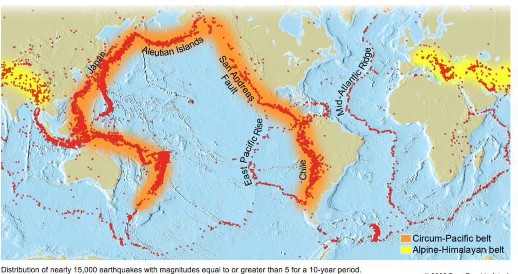1.5.1. Seismic Belts of the world

The main seismic belts are as under:
1. Circum-Pacific Belt: The Belt includes the coastal margins of North America, South America and East Asia. These are as represent the eastern and western margins of the Pacific Ocean respectively, and account for about 65 per cent of the total earthquakes of the world.
The western marginal zones are represented by the Rockies and the Andes mountain chains. These are also the zones of convergent plate boundaries where the Pacific oceanic plate is subducted below the American plates.
The eastern marginal zones are represented by the island arcs of Kamchatka, Sakhalin, Japan and Philippines. The earthquakes are caused due to collision of the Pacific and the Asiatic plates and the consequent volcanic activity. Japan records about 1500 seismic shocks every year.
2. Mid-Continental Belt: The Mid-Continental Belt includes the Alpine mountains and their off shoots in Europe, Mediterranean Sea, northern Africa, eastern Africa and the Himalayas. The Mid-Continental Belt extends through Sulaiman and Kirthar zones in the west, the Himalayas in the north and Myanmar in the east. This belt represents the weaker zone of Fold Mountains. About 21 per cent of the total seismic events are recorded in this belt.
3. Mid-Atlantic Ridge Belt: The Mid-Atlantic Ridge Belt includes the Mid-Atlantic ridge and several islands near the ridge. It records moderate earthquakes which are caused due to the moving of plates in the opposite directions. Thus the seafloor spreading and the fissure type of volcanic eruptions cause earthquakes of moderate intensity in this region.

